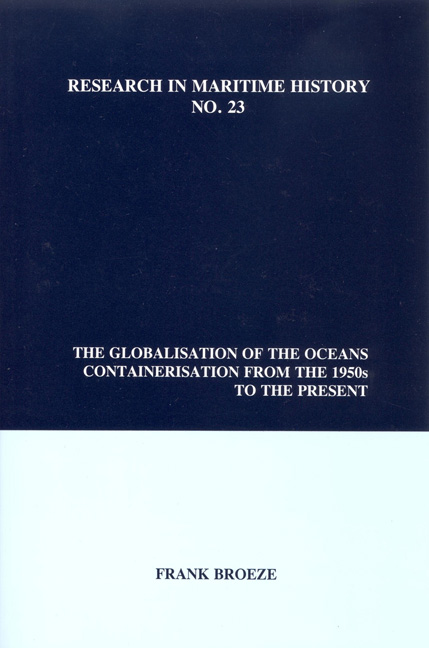Book contents
- Frontmatter
- Table of Contents
- List of Figures
- List of Tables
- Abbreviations
- Acknowledgments
- Preface
- Introduction
- Chapter 1 A Concept and its Realisation
- Chapter 2 The First Revolution
- Chapter 3 The 1970s: Conquering the World
- Chapter 4 The 1980s: Crisis and the Second Revolution
- Chapter 5 The 1990s: Globalisation
- Chapter 6 Ports, Port Systems and Liner Networks
- Chapter 7 Maritime Labour
- Chapter 8 Culture, the Environment and Recycling
- Conclusion
- Select Bibliography
Chapter 2 - The First Revolution
- Frontmatter
- Table of Contents
- List of Figures
- List of Tables
- Abbreviations
- Acknowledgments
- Preface
- Introduction
- Chapter 1 A Concept and its Realisation
- Chapter 2 The First Revolution
- Chapter 3 The 1970s: Conquering the World
- Chapter 4 The 1980s: Crisis and the Second Revolution
- Chapter 5 The 1990s: Globalisation
- Chapter 6 Ports, Port Systems and Liner Networks
- Chapter 7 Maritime Labour
- Chapter 8 Culture, the Environment and Recycling
- Conclusion
- Select Bibliography
Summary
Containerization made…a stormy, hectic era for shipping, embracing as it did changes comparable in scale to the great transition, seventy-five years earlier, from sailing ships to steamers.
Conceptualising the solution to an economic problem is one thing; to bring it to practical application is another; and to make the new system work profitably is quite another matter again. The past is strewn with ideas and inventions that remained just that. But the progress of those that ultimately were successful often was slow and erratic, partly because the knowledge of materials and their properties was imperfect and needed to be developed simultaneously, partly also because the grim reality of the market and the financial bottom line.
The steamship, for example, did not replace the sailing ship and conquer the oceans either immediately or in a smooth and gradual process like the one so gracefully represented in the “ideal-types” offered by Griliches in his pioneering study on the diffusion of hybrid maize or by Harley to illustrate the transition from sail to steamThe development and commercial diffusion of the steamship was characterised by alternating stages of spectacular innovation and careful piece-meal consolidation over a period of about a century. Moreover, the pace and extent of its diffusion varied markedly between the four main sectors of the shipping market: rivers, short-sea, deep-sea liner trade and global tramping. No single pattern can ever adequately describe the steamer's progress during the nineteenth century, if only because there was not a single “ideal-type” steamship in a single global freight market. Yet historians all agree that the adoption of the steamship brought a total revolution in international shipping, especially in the creation of the global liner industry.
Not surprisingly, in its historical significance and revolutionary impact containerisation is often compared by both historians and shipping professionals to the introduction of steam navigation. As Mitsui-OSK's president Kiichiro Aiura put it succinctly in 1985, “Containerization made.. .a stormy, hectic era for shipping, embracing as it did changes comparable in scale to the great transition, seventy-five years earlier, from sailing ships to steamers.“
- Type
- Chapter
- Information
- The Globalisation of the OceansContainerisation from the 1950s to the Present, pp. 27 - 50Publisher: Liverpool University PressPrint publication year: 2000



